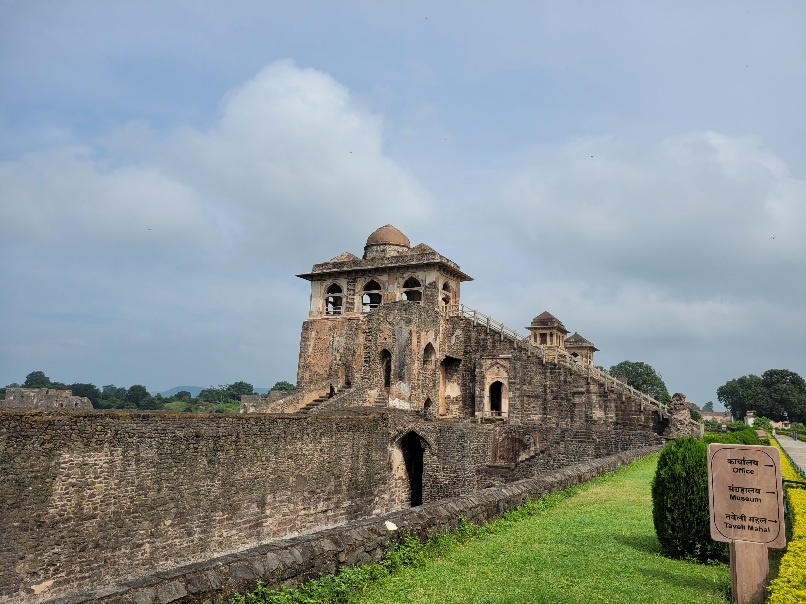When you are visiting Madhya Pradesh and particularly Indore, do travel a bit further and visit the historic city of Mandu. The fortified city is home to a group of historic monuments that has been accorded UNESCO World Heritage Site status in 2004. But one monument that will blow your mind is the Jahaz Mahal,an architectural marvel which mesmerises its visitors with its unique shape: built on a narrow strip of land between Munj Talao and Kapur Talao with the appearance of an anchored ship.
The Jahaz Mahal complex also known as Royal Enclave is home to some of the best monuments that Mandu has to offer. The majestic Jahaz Mahal along with the other monuments calls for mandatory visit when you are in Mandu.
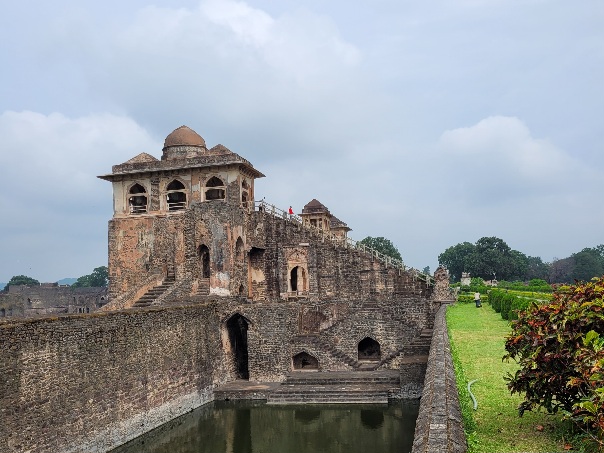
Post Contents
History and architecture of Jahaz Mahal of Mandu
Mahal was built by Sultan Ghiyasuddin Khilji as a harem and it extends over a length of 112 m and a width of 15 m. Architecture with an amalgam of Afghan, Mughal, Hindu, and Mesopotamian architecture styles, Jahaz Mahal is one of the most famous monuments that have completely transformed and redefined tourism in Mandu.
The palace is a two-storied building and is adorned with intricate carvings and sculptures that are a testament to the high level of craftsmanship of that era.One of the most striking features of the Jahaz Mahal is its double-storied arcade that runs along the entire length of the palace on the upper floor. This arcade is punctuated by a series of arched openings that provide a breathtaking view of the surrounding landscape. The palace also has a series of rooms, halls and courtyards thaJahaz t were used for various purposes, such as residential quarters, audience halls, and a mosque.
The Jahaz Mahal was not just a palace but also served as a harem for the royal ladies. The palace was also used as a pleasure resort by the royal court and was a popular destination for royal parties and celebrations. The palace was also used as a place of worship and had a mosque built on the grounds.The palace was abandoned after the fall of the Sultanate of Mandu in the 16th century. The palace fell into ruin and was forgotten for centuries. The palace was rediscovered in the 19th century by British archaeologist Sir Alexander Cunningham who was exploring the ruins of Mandu.
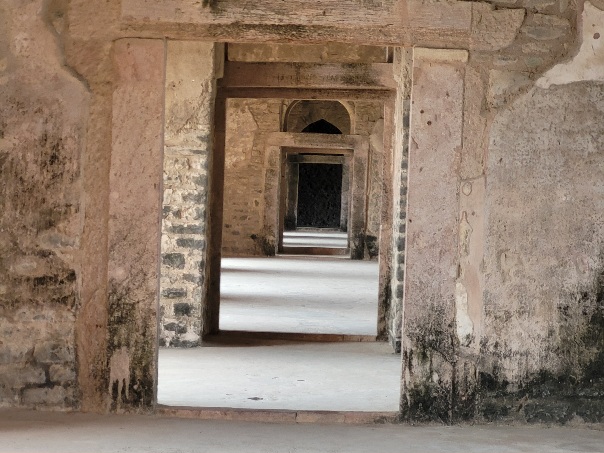
The Jahaz Mahal, along with the other monuments in Mandu, was built using locally quarried sandstone. The palace has undergone significant restoration work in recent times to preserve its architectural beauty and rich history. Today, it serves as a popular tourist destination, drawing visitors from all over the world to marvel at its beauty and learn about its rich history.
Jahaz Mahal of Mandu is a masterpiece of architectural design and a testament to the rich cultural and historical heritage of the region. It is a must-see destination for anyone interested in Indian history and architecture. With its unique location, intricate carvings, and breathtaking views, the Jahaz Mahal is truly a gem of the region and a symbol of the grandeur and splendor of the past.
Similar Article: Qutub Minar: The Towering Landmark of Delhi
Other monuments in the Jahaz Mahal complex
The Jahaz Mahal complex also known as Royal Enclave boasts of several other monuments which adds to the beauty of the palace and are worth visiting. Some of the monuments have been restored and preserved well while few others are in ruin. The monuments that draw attention include Hindola Mahal, Nahar Jharokha, Champa Baodi, Taveli Mahal and Gada Shah shop.
Let’s explore the monuments in the Royal Enclave or the Jahaz Mahal complex.
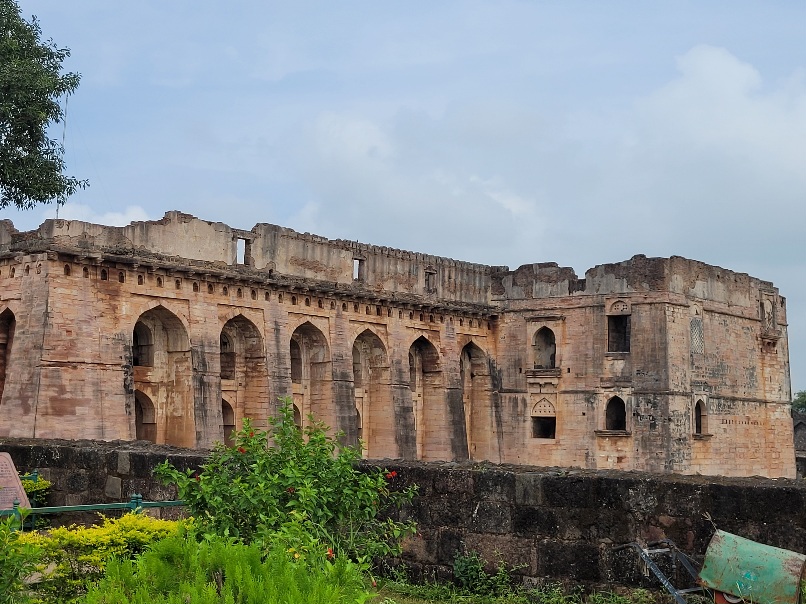
Hindola Mahal
After you are done with Jahaz Mahal, now it is time to visit other monuments in the palace complex. After walking a good 100 meters you come across Hindola Mahal which literally translates to “swinging palace,” a name given to it because of its unusually sloped sidewalls. The building has a T-shaped plan with a main hall and a transverse projection on the north side. This projection seems to have been added later.On both sides of the hall, there are six arched openings above which there are windows filled with beautiful tracery work for admitting light and air inside.
Except for a couple of bands of carved mouldings, the building’s exterior is extremely simple. The ornamentation has been kept to a minimum; even the coloured tiles that are commonly used in other Mandu buildings have been abandoned here.
The T-shaped projection was probably added later to provide a safe approach for the king. Since it is popularly known as Hathi-Chadhao, there is a flight of sloping steps at the back of the building designed for royal ladies to ascend in a palanquin, pony, or elephant. Hindola Mahal is a must-see monument in the Jahaz Mahal complex.
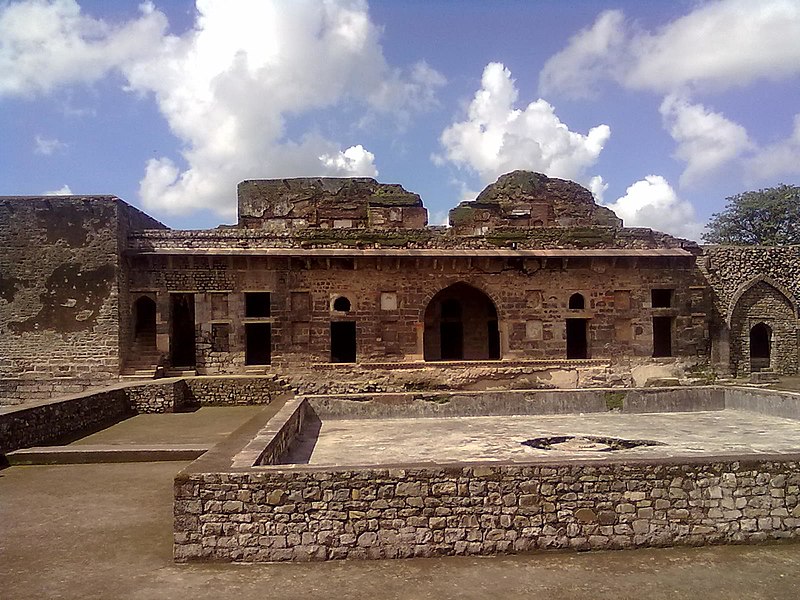
Do Read: Sanchi Stupa: All you need to know about this Buddhist treasure
Nahar Jharokha
Nahar Jharokha is another historical structure in Mandu which is part of the Royal Group of Monuments. It is one of the most popular Mandu tourist attractions, located adjacent to the Hindola Mahal within the Jahaz Mahal complex.
Nahar Jharokha is a fragmented balcony of a palace near Hindola Mahal. It was used by the Sultan of Malwa to allow his subjects to see him. The large open balconies of Nahar Jharokha lead to a large courtyard where the public gathered to meet the king. During the Sultanate’s rule, the subjects came here every morning to catch a glimpse of their king. This tradition is said to have begun before Mughal ruler Akbar arrived in Mandu..
Nahar Jharokha is also known as ‘Tiger Balcony,’ because it used to be supported by a tiger effigy. A Mughal-era double-story building stands behind the balcony. On both floors, there are rooms in a row, and the ground floor is divided into three sections by halls. The building’s courtyard features a square water tank in the centre with the remains of a fountain. Rooftop rainwater was routed to the tank via an aqueduct. This is a very interesting monument and you must not miss it.
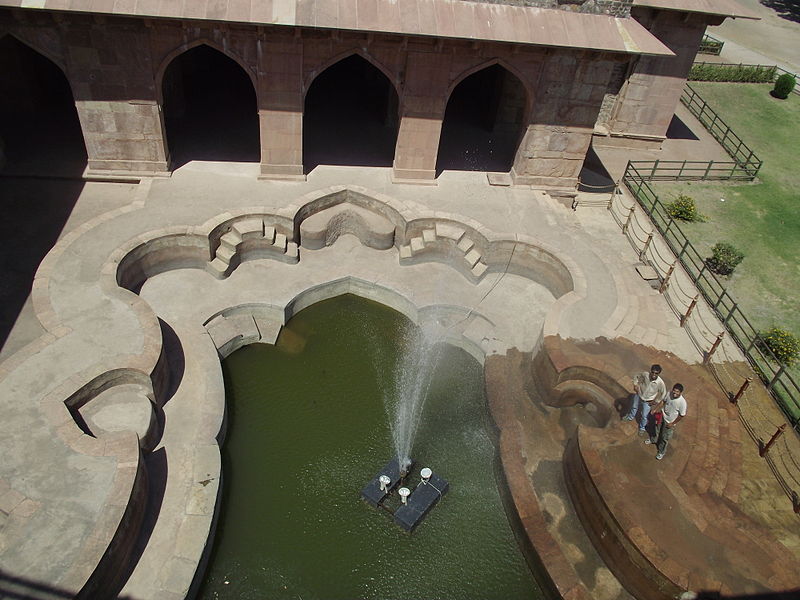
Champa Baodi and Hammam Ghar
Champa Baodi is an ancient stepwell in Mandu Fort in Mandu. It is one of the best places to visit in Mandu and is located to the northwest of Jahaz Mahal.
Champa Baodi is a historical structure located in the heart of the Jahaz Mahal complex. It is a huge stepwell that was inspired by the styles of Turkish baths and is part of the Royal Group of Monuments. This location was given the name Champa Baoli because the aroma of the waters was thought to resemble that of the Champa flower. It is a must-see for all tourists visiting Mandu.
It was Mughal architecture at its best. The vaulted rooms, known as Taikhanas, were well connected to keep the bath cool even in extreme heat. The structures of the chambers in the cellars built inside this stepwell resemble a maze. Lower ground levels have very narrow passages.
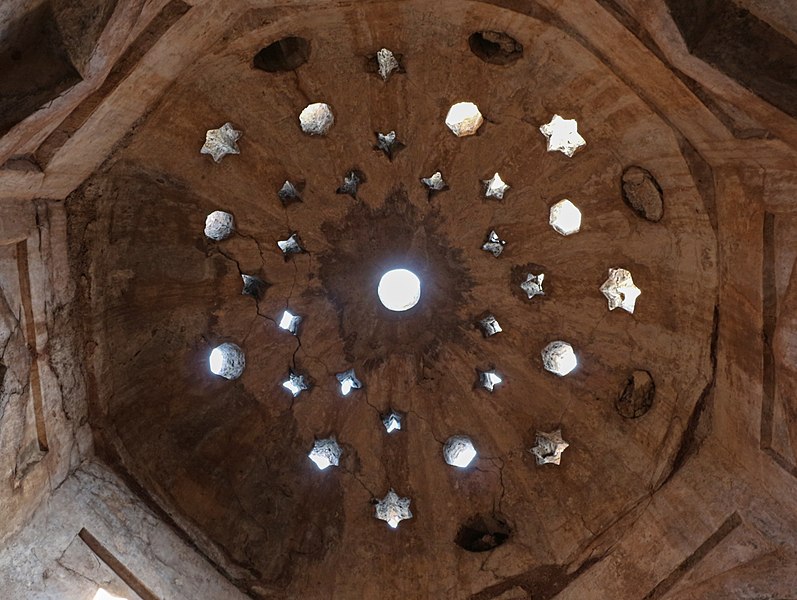
Bernard Gagnon/Wikimedia Commons
Also Read: A trip to the Udayagiri caves near Bhopal
One of them is linked to the Munj Pond by a corridor leading to the pavilion on the western side. This basement’s walls are arched. The stairs leading to the stepwell’s lower floor are in the centre of these walls. During the construction of Champa Baodi, proper air and light management was also implemented.
You only marvel at the engineers of the time and their skills. This stepwell was built not only for water management, but also to protect against enemy attacks at the time. In the event of an invasion, the women of the royal family who lived here used to jump into this stepwell, passing through the basements via the secret passages built into it.
Near the Champa Baodi, there is also a Turkish-style Royal Hammam, or hot bath, which was used by the royals. It consists of three rooms of which two are still in good condition and one is destroyed. Its ceiling is decorated with beautiful stars that have been cut for light, giving the appearance of twinkling stars shining in the sky around the full moon even during the day. There is hot and cold water available in the underground rooms.Champa Baodi used to feed water to this bath.
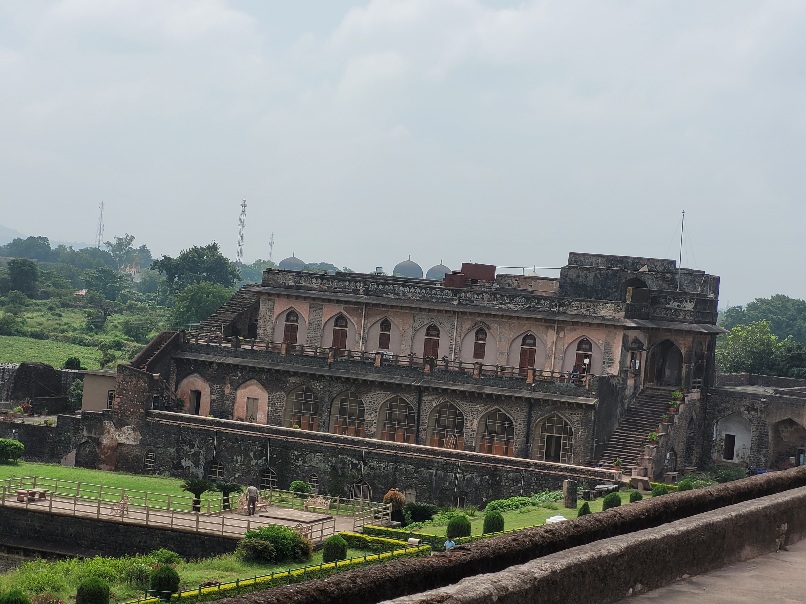
Taveli Mahal
As you enter the Royal premise or the Jahaz mahal Complex you can see Taveli Mahal on the right side.. It’s on the other side of the Jahaz Mahal. Taveli Mahal was the royal family’s stable and was called “Tabela”. With the passage of time, this building has come to be known in its current name, Taveli Mahal. This building’s ground floor has three rooms, with the outer room being considerably larger than the other two. The outer room in the front must have served as a stable for horses, while the smaller ones in the back must have housed baby horses and fodder.
Just as the ground floor has three rooms, the upper floor has three rooms as well. On the top, there is an open terrace with a beautiful view of the Jahaz Mahal. The ground floor of this building now houses the Central Archaeological Department’s office as well as a museum. The upper floor has been changed into a rest house. Pandit Jawaharlal Nehru, India’s first Prime Minister, stayed at this rest house. As a memento of his stay, the room where he stayed has a plaque.
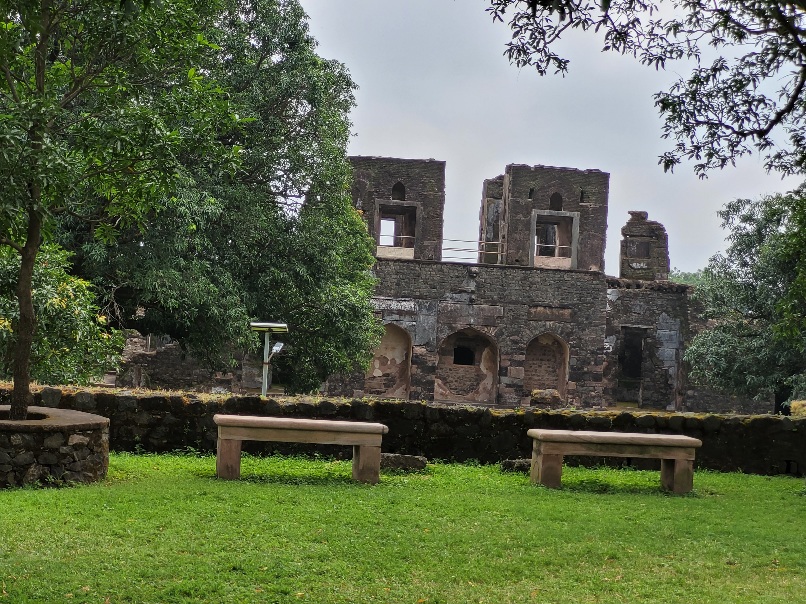
Do Read: Ellora Cave Monuments: Spirit of co-existance and religious tolerance through rock architectures
Gada Shah’s shop and house
This place is part of Mandu’s Royal Complex near Kapur Talao but it is off the beaten path. The palace is supposed to be the factory and shop of Gada Shah, the beggar king, and is now in ruins, with only the main arch remaining.
I was here on my recent trip to Mandu and was blown away by the size.
Gada Shah is said to have been a Rajput merchant who dealt in ivory, saffron, and musk. This structure is close to the two step wells Andheri Baodi and Ujala Baodi.
The ruin itself is imposing, and very well-maintained. You can even climb up to what remains of the second floor. The missing roof lets you see the sky against the surviving arches/niches and then there are the empty rooms where silence speaks.
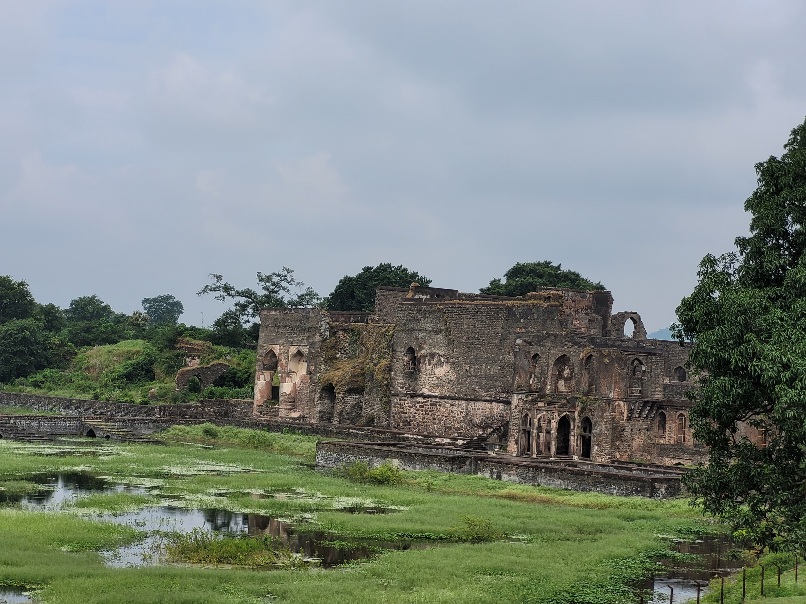
How to Reach Mandu
By Air
Devi Ahilyabai Holkar Airport in Indore is the nearest airport. There are regular flights from Delhi, Mumbai, Pune, Jaipur, Hyderabad, Bhopal, Ahmedabad, Nagpur, Raipur and Kolkata
By Train
Indore is the nearest city having Railway Stations well connected from major stations of India.
By Road
Mandu is well connected from Indore (95 km) and Dhar (35 km). From Indore there are two direct bus to Mandu, the first from Gangwal Bus Stand (08:00) and second from Sarawate Bus Stand (14:00). The journey takes 3 hours. Alternatively one can make a break journey at Dhar.
There are regular bus service from Indore to Dhar and from Dhar to mandu. You can rent a car in Indore. The best route from Indore is as follows: Indore – Betma – Ghatabillod – Dhar – Mandu. The distance is approximately 95 km and the roads are in good condition.
FAQs
The best time to visit Mandu is from October-March as this period experiences moderate weather. The summers are quite hot from March to May, just like the other parts of Madhya Pradesh, and the winters are comparatively more pleasant.
For a casual visitor 1-2 hours is sufficient. But if you are a history or art enthusiast and want to visit seriously, then you should spend at least 3 hours. Apart from the Jahaz Mahal, the royal enclave has several other monuments that you must visit.
This two-storied architectural marvel, between two artificial lakes, is so named because it appears to be a ship floating in water. Sultan Ghiyas-ud-din-Khalji built it as a harem for the sultan.
The splendid architecture of Jahaz Mahal occupies an expense in the Mandu region of Madhya Pradesh. It was built during the reign of Mandu Sultan Ghiyas-ud-din Khilji, who is believed to have as many as 15,000 women as his consorts.

